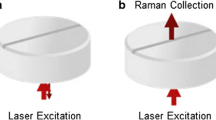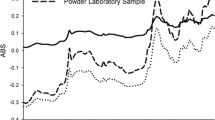Abstract
Global regulatory agencies have encouraged the use of process analytical technology (PAT) to assure quality in the pharmaceutical industry. A frequently cited obstacle to the implementation of spectroscopy-based PAT methods is the difficulty associated with directly transferring calibration models between PAT instruments. The goal of this study was to compare model transfer strategies for method transfer between two transmission Raman spectroscopy (TRS) instruments. The calibration and test samples were pharmaceutical compacts of acetaminophen and excipients. The experimental design was a 3 factor by 5 level circumscribed central composite design of active pharmaceutical ingredient, lactose, and microcrystalline cellulose concentrations. The calibration and test data were collected using two instruments. Quantitative models were constructed using partial least squares regression. Global calibration modeling and direct model transfer were compared to evaluate opportunities for situations involving method transfer, calibration update, and line extension. Models were compared using a t test-based method to evaluate performance statistics. Statistical analysis demonstrated equivalent performance of the global modeling and direct transfer methods. This work demonstrated that a quantitative transmission Raman model could be directly transferred across instruments, thus avoiding the challenges and resources necessary when creating global models.








Similar content being viewed by others
References
U.S. Department of Health and Human Services. Pharmaceutical cGMPS for the 21st Century—A Risk-Based Approach. Rockville; 2004.
U.S. Department of Health and Human Services. Guidance for Industry: PAT—A Framework for Innovative Pharmaceutical Development, Manufacturing, and Quality Assurance. Rockville; 2004.
International Conference on Harmonisation. Pharmaceutical Development Q8(R2). Geneva; 2009.
EMEA. Guideline on the use of near-infrared spectroscopy by the pharmaceutical industry and the data requirements for new submissions and variations, vol. 16. London: European Medicines Agency; 2009. p. 1–30.
Moes J, Ruijken M, Gout E, Frijlink H, Ugwoke M. Application of process analytical technology in tablet process development using NIR spectroscopy: blend uniformity, content uniformity and coating thickness measurements. Int J Pharm. 2008;357(1–2):108–18.
De Beer T, Bodson C, Dejaegher B, Walczak B, Vercruysse P, Burggraeve A, et al. Raman spectroscopy as a process analytical technology (PAT) tool for the in-line monitoring and understanding of a powder blending process. J Pharm Biomed Anal. 2008;48(3):772–9. https://doi.org/10.1016/j.jpba.2008.07.023.
Hu Y, Liang JK, Myerson AS, Taylor LS. Crystallization monitoring by Raman spectroscopy: simultaneous measurement of desupersaturation profile and polymorphic form in flufenamic acid systems. Ind Eng Chem Res. 2005;44:1233–40.
Kauffman JF, Dellibovi M, Cunningham CR. Raman spectroscopy of coated pharmaceutical tablets and physical models for multivariate calibration to tablet coating thickness. J Pharm Biomed Anal. 2007;43(1):39–48.
Feng H, Bondi RW Jr, Anderson CA, Drennen JK III, Igne B. Investigation of the sensitivity of transmission Raman spectroscopy for polymorph detection in pharmaceutical tablets. Appl Spectrosc. 2017; 0003702817690407.
Li Y, Igne B, Drennen JK, Anderson CA. Method development and validation for pharmaceutical tablets analysis using transmission Raman spectroscopy. Int J Pharm. 2016;498(1):318–25.
Strachan CJ, Rades T, Gordon KC, Rantanen J. Raman spectroscopy for quantitative analysis of pharmaceutical solids. J Pharm Pharmacol. 2007;59(2):179–92.
Pelletier MJ. Quantitative analysis using Raman spectrometry. Appl Spectrosc. 2003;57(1):20A–42A.
Taylor LS, Zografi G. The quantitative analysis of crystallinity using FT-Raman spectroscopy. Pharm Res. 1998;15(5):755–61.
Bell SEJ, Beattie JR, McGarvey JJ, Peters KL, Sirimuthu NMS, Speers SJ. Development of sampling methods for Raman analysis of solid dosage forms of therapeutic and illicit drugs. J Raman Spectrosc. 2004;35:409–17. https://doi.org/10.1002/jrs.1160.
Johansson J, Pettersson S, Folestad S. Characterization of different laser irradiation methods for quantitative Raman tablet assessment. J Pharm Biomed Anal. 2005;39(3–4):510–6.
Feudale RN, Woody NA, Tan H, Myles AJ, Brown SD, Ferré J. Transfer of multivariate calibration models: a review. Chemom Intell Lab Syst. 2002;64(2):181–92.
Fearn T. Standardisation and calibration transfer for near infrared instruments: a review. J Near Infrared Spectrosc. 2001;9(4):229–44.
Kessler W, Oelkrug D, Kessler R. Using scattering and absorption spectra as MCR-hard model constraints for diffuse reflectance measurements of tablets. Anal Chim Acta. 2009;642:127–34.
Bondi RW Jr, Igne B, Drennen JK III, Anderson CA. Effect of experimental design on the prediction performance of calibration models based on near-infrared spectroscopy for pharmaceutical applications. Appl Spectrosc. 2012;66(12):1442–53.
Boddy R, Smith G. “Central composite designs”. Effective experimentation for scientists and technologists. Chichester: John Wiley and Sons, Ltd.; 2010. p. 121–33.
Ahmad IQBAL, Shaikh RIAZHUSSAIN. Stability of paracetamol in packaged tablet formulations. Pak J Pharm Sci. 1993;6(2):37–45.
De Jong S. SIMPLS: an alternative approach to partial least squares regression. Chemom Intell Lab Syst. 1993;18:251–3.
Fearn T. Comparing standard deviations. NIR News. 1996;7:5–6.
Naes T, Isaksson T, Fearn T, Davies T. Validation: a user-friendly guide to multivariate calibration and classification. Chichester: NIR Publications; 2002. p. 155–76.
Norgaard L, Saudland A, Wagner J, Pram Nielsen J, Munck L, Balling Engelsen S. Interval partial least-squares regression (iPLS): a comparative chemometric study with an example from near-infrared spectroscopy. Appl Spectrosc. 2000;54(3):413–9.
Acknowledgments
Special thanks are extended to Shikhar Mohan and Yuxiang Zhao for their advice and assistance during the execution and evaluation of this research.
Author information
Authors and Affiliations
Corresponding author
Additional information
This study compared direct transfer vs. global modeling as calibration transfer strategies between two transmission Raman spectroscopy instruments. The results showed that direct transfer could be performed without significant loss in model performance.
Rights and permissions
About this article
Cite this article
Steinbach, D., Anderson, C.A., McGeorge, G. et al. Calibration Transfer of a Quantitative Transmission Raman PLS Model: Direct Transfer vs. Global Modeling. J Pharm Innov 12, 347–356 (2017). https://doi.org/10.1007/s12247-017-9299-4
Published:
Issue Date:
DOI: https://doi.org/10.1007/s12247-017-9299-4




